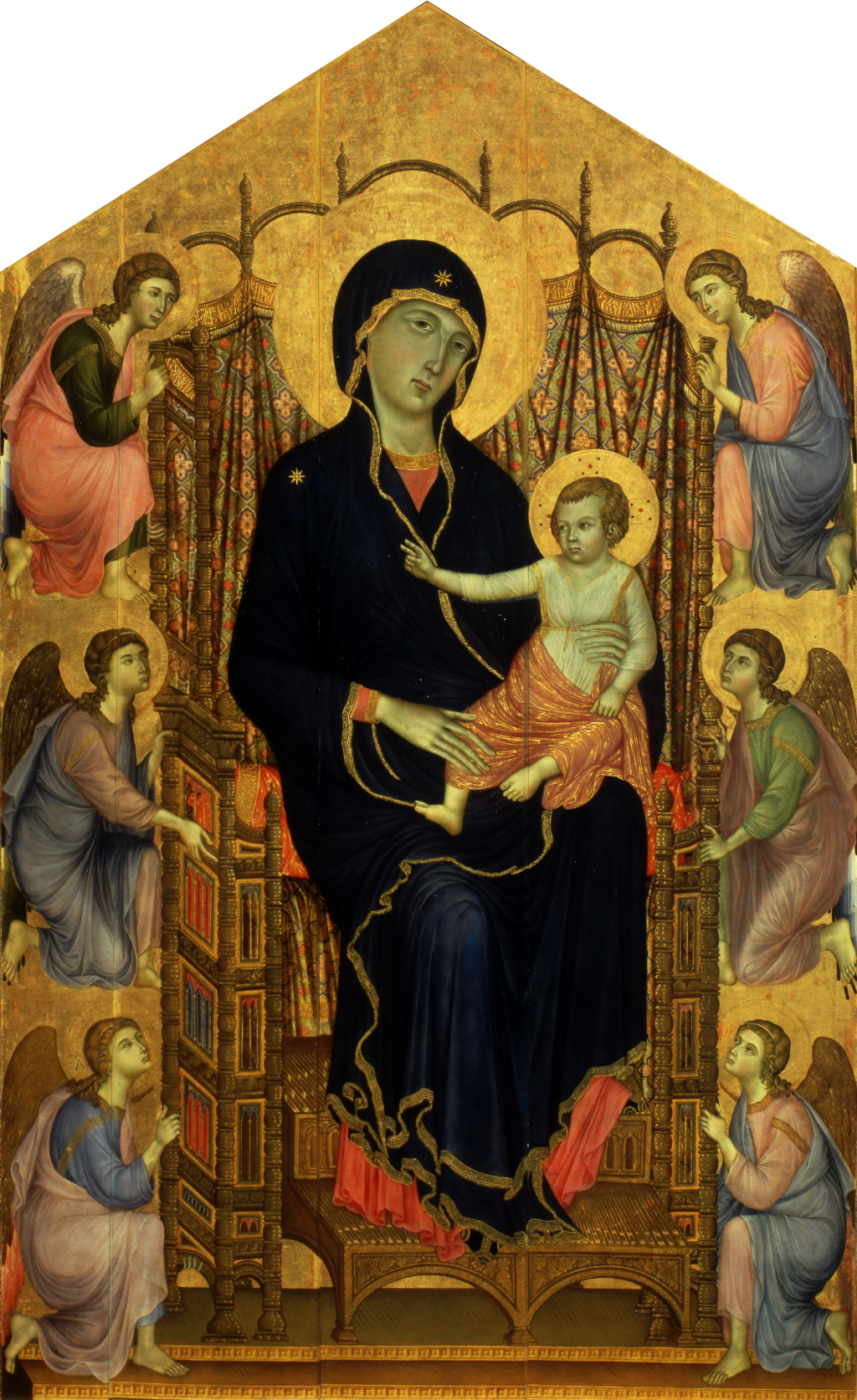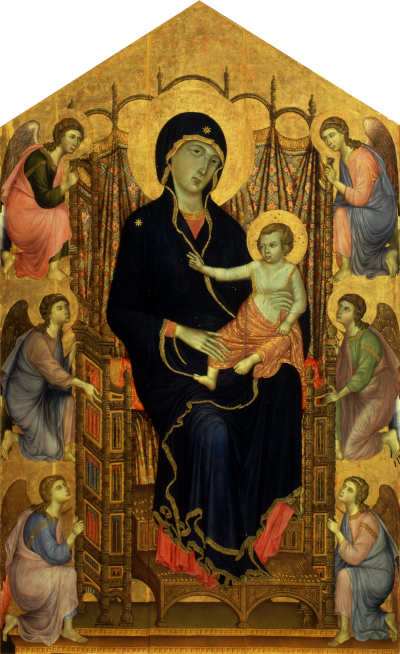The Rucellai Madonna was produced by Duccio di Buoninsegna in the late 13th century and is considered to be one of the most famous artworks from that important period.
Artists such as Duccio, Cimabue and Giotto would lay the groundwork for the Italian Renaissance with a series of technical advancements. Duccio himself came from Siena, a small city which would leave an important artistic legacy of its own, establishing an influential school which would produce several important artists. Duccio would build a strong reputation for his work and would receive regular commissions, with a surprising number of his paintings still surviving to the present day. Many other famous names from this period have just a few artworks remaining and the attributions even of those can sometimes come into question. Artists from this period would regularly call on the services of their assistants who would be taught to paint in a similar manner, and with many documents being lost over the centuries, this has made attributing some of these items somewhat difficult.
Duccio was from Siena and this region was famous for its specialisation in Madonna depictions. He was therefore ideal for this commission, even though normally local artists would be selected instead. Duccio was willing to travel for his work and this brought about many more opportunities that he otherwise would have missed out on. Siena was also not a particularly large town, and so he quickly realised that flexibility was key to him building a strong reputation across the different regions of Italy. Madonnas would appear many times within his oeuvre as a result of his success, and as more potential donors saw his work, so they might ask for similar content for their own locations. It has taken many centuries for historians to correctly attribute some of these items from the 13th and 14th century, which now provides a route through towards the early stages of the Renaissance.
The Rucellai Madonna stands at over four and a half metres tall and nearly three metres wide, making it hard to accomodate in most modern buildings. The Uffizi has carefully planned out a specific room in which it hangs alongside a number of other related pieces from the 13th and 14th century. Some excellent preservation work has ensured that the original tones are still bright today. The contract produced for this project is also believed to be one of the earliest documents of this type still in existence, giving another historical significance to the painting. The Rucellai Madonna remains one of the most famous Duccio paintings of all, but was actually just one of a large number of Madonna paintings that he produced across his lifetime.
Table of Contents
- Description of the Painting
- Where can the Rucellai Madonna be found Today?
- When was the Artwork Produced?
- Did Duccio Create any other Madonnas?
- What is the Meaning of the Madonna?
- What Techniques did Duccio use for the Rucellai Madonna?
- Who Commissioned this Painting?
- What is the History of the Rucellai Madonna?
- Which Paintings are displayed alongside the Madonna in the Uffizi?
- Large Image of Rucellai Madonna
Description of the Painting
This artwork was wrongly attributed to Cimabue for many centuries, partly due to an error by otherwise respected historian, Giorgio Vasari. This delightful artwork features six angels placed around the Madonna and Child. These two figures are oversized to signify their importance, and enthroned upon a beautiful piece of ornate furniture. Duccio plays with perspective and angles, but most artists at this time were using flattened imagery. It would only be in later centuries that the use of perspective developed into something more accurate and realistic. The donor would instruct specifically as to the colours to be used for the clothing of the Madonna and Child, with red and blue being used for them in most depictions of this period. The angels' hold expressions of awe as they stare in wonder at the Madonna and Child. Gold paint is then used to cover the entire background, bringing an elegance and brightness to the final piece.
Where can the Rucellai Madonna be found Today?
The Rucellai Madonna can be found in the Uffizi gallery, which is based in the Italian city of Florence. It was switched to the Galleria degli Uffizi in the 19th century, which explains how this artwork remains in such good condition, all these years later. At the time of being commissioned it was intended for the Dominican church of Santa Maria Novella, before later being moved to a chapel close by. It remains one of the biggest attractions at the Uffizi, with this important period of Italian art continuing to attract art history enthusiasts from right across the world. Indeed, when one understands the importance of the Renaissance, it is also crucial to learn about those who laid made the initial developments that led to its arrival.
When was the Artwork Produced?
Contracts were signed for this painting on the 15th of April, 1285. The artwork would then have been completed shortly after this point, but a precise date cannot be determined. Rucellai Madonna remains the largest painting ever to have been discovered from the 13th century and so can be considered a truly ambitious piece, for which the artist was paid 150 lire. Smaller pieces were common at this time, with the intention of being used as private, devotional artworks but in this case the final location was more spacious and so it was decided to produce something much larger. Out on display within the Uffizi, it is afforded plenty of room alongside a number of other key artworks from what has become known to many as the Proto-Renaissance era.
Did Duccio Create any other Madonnas?
The Madonna appears many times within Duccio's oeuvre, partly due to the fact that Sienese artists tended to concentrate on this topic more than any other Italian region. Maestà, Madonna and Child, Crevole Madonna, Madonna with Child and Six Angels and Gualino Madonna are just a few of the examples available as Duccio is rare in having so many artworks left from his career. Siena was famous for its use of this iconic image and that allowed Duccio to take on projects elsewhere in Italy, with donors wanting the best completed piece possible. Any artist willing to travel would also be able to expand and strengthen their reputation much faster, with a number of Italian provinces fighting for artistic prominence over the next few centuries, with the battlegrounds being fought over sculpture, painting and architecture.
What is the Meaning of the Madonna?
The image of the Madonna and Child is meant to remind us of her love for her child. They would often be placed alone together, or separated in some way from other figures within a composition. Another technical aspect used within these paintings would be to enthrone them centrally within the piece, and enlarge these figures in comparison to others in the same painting. This would underline their importance within Christianity and they would often be lifted up, with the supporting angels and saints being lower down within the composition. This clear symbolism would be passed through generations of artists and across the various Italian art schools which were starting to appear at that time. Variations upon this theme would come about in later centuries as a greater artistic freedom started to take hold.
What Techniques did Duccio use for the Rucellai Madonna?
The patron would supply the framed panel for this project and also reserved the right to refuse the painting within the terms of the agreement. Duccio used tempera and gold on panel in order to complete this piece and these were common methods for that period, continuing into the 14th century. It was only the later influence of North Europeans which led to Italian painters switching from fresco and tempera techniques to oils. The painting was restored as recently as 1989 which enables us to see more of the original colours than was previously possible. Inevitably, some of the paint used by the artist had lost its impact over time as a result of being displayed for centuries within historic buildings. The Madonna became a key part of the Sienese art style, meaning it made sense to select an artist for this project from that city.
Who Commissioned this Painting?
This ambitious artwork was commissioned for the Dominican church of Santa Maria Novella in Florence which had only recently been completed. The donor, the Compagnia dei Laudesi, wanted to complete this building by adding breathtaking art from the finest local painters and sculptors. The Rucellai Madonna was to be placed upon the altarpiece and so they went about acquiring the services of Duccio for this project, with his reputation being considerable at that time. They were a confraternity devoted to the Virgin, making the content of this artwork entirely suitable, and also something that they likely would have decided upon themselves. Several centuries later the painting was moved to the Rucellai family chapel which was situated close by and offered more room for this unusually large piece.
What is the History of the Rucellai Madonna?
The artwork was commissioned in 1285, and then likely completed in the following year. The Laudesi confraternity of Florence, who had paid for this piece, would then install it within their chapel in the Dominican church of Santa Maria Novella in Florence. It would remain here until 1591 at which point it would be relocated to another, larger, chapel close by. Eventually this critical piece would be moved to the Uffizi gallery elsewhere in Florence at some point in the 19th century. It has remained there ever since and is a part of a room devoted to Giotto di Bondone and a number of related artists from the 13th and 14th century, including Duccio himself. The Uffizi has a wealth of skilled staff on hand to ensure its protection for centuries to come and have completed several restoration projects on this piece alone.
Which Paintings are displayed alongside the Madonna in the Uffizi?
Head to Hall 2, "Giotto & the 13th Century", on the second floor of the Uffizi to see this painting in person. It has been joined in this large room by a number of other famous, related artworks such as Giotto's Madonna Ognissanti, from around 1310, and also Cimabue's Maestà of Santa Trinita, which was painted between 1280 and 1290. These important pieces can be compared and contrasted by visitors to see how each artist chose to depict this iconic image. Elsewhere within the building you will find a wider variety of items, also including sculpture, covering various movements up towards the Baroque, with North European artists also included in good numbers as well. It remains one of the most important and popular art galleries anywhere in the world.
Large Image of Rucellai Madonna





